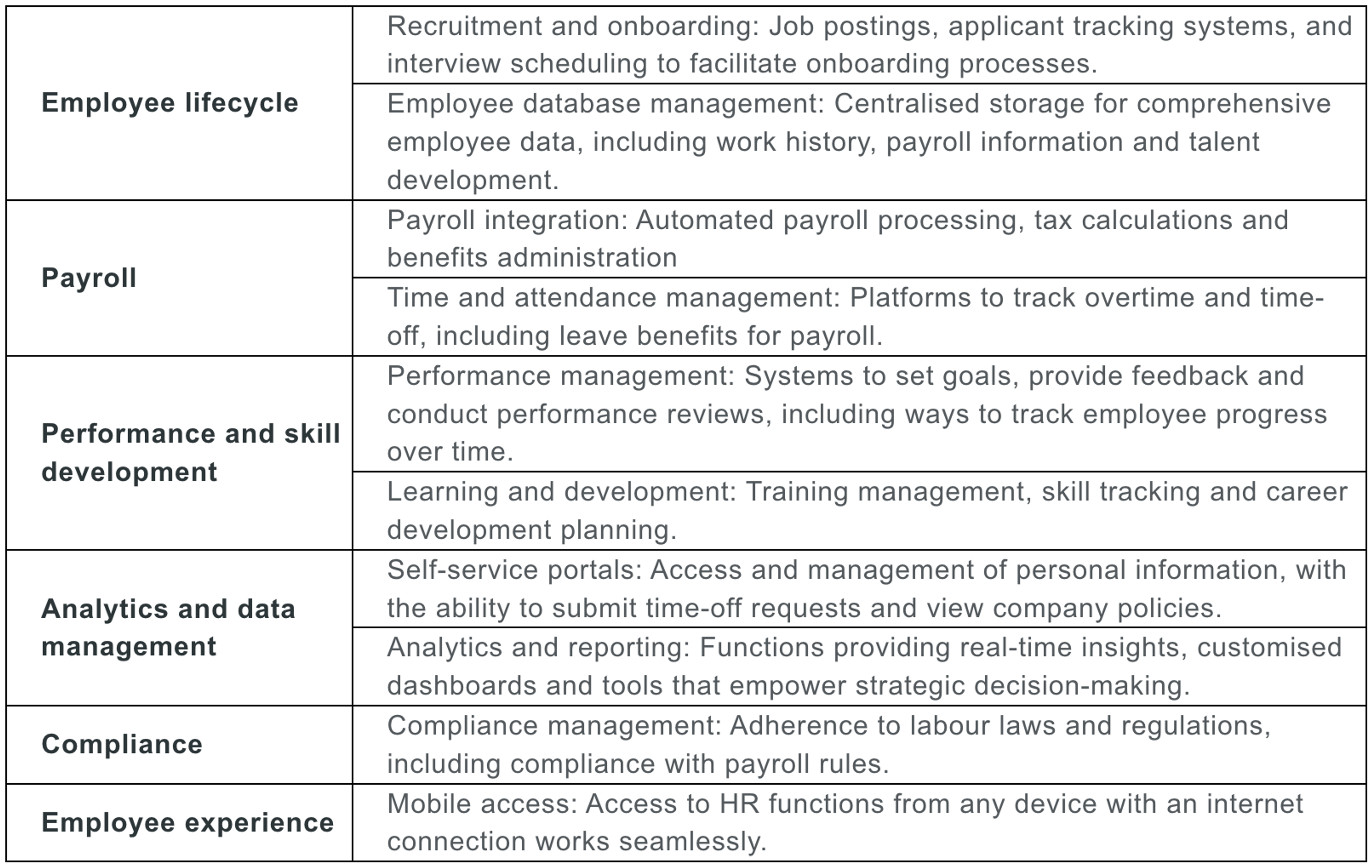Cloud-based HRMS: Transforming human resource management
Organisations' Human Resource Management is undergoing a significant transformation. Leading the charge are cloud-based Human Resource Management Systems (HRMS).
Liam Clark

These web-based platforms enable businesses to streamline HR processes, enhance operational efficiency, and adapt to the demands of a modern, dynamic workforce.
Unlike traditional on-premise systems, cloud HRMS provide greater accessibility, scalability, and cost-effectiveness. They are a vital tool for organisations looking to optimise their HR functions.
This article delves into these key features, benefits, and challenges. We’ll explore how cloud-based HRMS are reshaping HR management and empowering businesses to stay agile and competitive.
Cloud-based HRMS explained
Cloud-based HRMS refers to web-based platforms enabling organisations to manage their HR functions. Instead of operations being tied to on-premise hardware, the cloud allows access without on-premise infrastructure. They are often Software-as-a-Service (SaaS) products, creating a more flexible approach to human resource management.
Cloud HR software and its increasing popularity are part of a wider trend towards moving away from on-premise infrastructure. The nature of the modern workforce—with many people working off-site—and technological improvements make cloud-based software a cost-effective solution for companies.
Read more about this topic

Key features of cloud HR software
Cloud-based HRMS features a wide range of tools to help human resource management processes. These frameworks focus on efficiency, data security, and a more user-friendly experience for both HR professionals and employees.
While the functionalities of cloud-based HR and payroll software depend on the specific platform, there are certain core functionalities that any good system should have. Key features can be divided into five core categories:

The core functionalities of cloud-based HRMS lead to tangible benefits that can transform an organisation’s operations. These systems collectively enhance operational efficiency, reduce costs, improve employee satisfaction, and enable organisations to focus on strategic growth initiatives.
By taking their HR processes to the cloud, companies can expect:
- Better accessibility and flexibility: Teams can access the system from anywhere, deepening collaboration, convenience, and transparency.
- Cost reductions: Eliminating the need for expensive hardware and IT infrastructure reduces the cost of operating HR systems.
- Enhanced efficiency via automation: Routine tasks can be automated and streamlined, improving turnaround times and reducing administrative burden.
- Improved data security: Cloud-based HR software offers advanced encryption, regular backups, and deeper security measures than most in-house systems.
- Effective employee engagement: Self-service portals can empower employees to better manage their employment and data. These features can foster a deeper sense of community, resulting in improved motivation.
- Better employer branding: Organisations can optimise their recruitment and onboarding experiences, creating a more coherent and positive brand experience for would-be employees.
- Strategic advantage: Real-time analytics and reporting tools also provide insights that can facilitate data-driven decision-making. This can improve the overall strategy, creating a more growth-oriented workforce planning strategy.
Sustainability is another additional benefit of cloud-based systems. Digitising processes such as payroll can significantly reduce paper usage and contribute to eco-friendly practices. As organisations start paying more attention to ESG matters, opting for a green cloud-based HR and payroll can be a powerful catalyst for meaningful organisational change.
Cloud-based vs traditional HR systems
This wide range of functionalities and benefits have led to an increase in cloud-based systems over traditional HR solutions. Below is a chart that compares some of the key requirements of HR solutions.
| Cloud-based HRMS | Traditional HR systems | |
|---|---|---|
| Access | Accessible from anywhere with an internet connection. | Tethered to physical servers, limiting access to on-premise locations. |
| Scalability | Adapts to organisational growth without significant disruption and need for additional hardware. | Expanding functionality may require costly infrastructure upgrades. |
| Cost | Low initial cost with continued monthly costs. | Higher upfront cost, with additional expenses in maintenance and overheads. |
| Updates | Automated and handled by the service provider. | Demands extensive in-house IT support for updates, with hardware upgrades often disrupting workflow. |
| Security | Advanced encryption and regular backups needed to ensure data protection. | While offering control, may lack the advanced security measures and suffer from location-based threats. |
| Analytics | Provides access to instant insight and vast amounts of data. | May not offer similar analytics capabilities or require more hardware investment for processing data. |
While traditional HR systems offer localised control and may fit specific organisational needs, cloud-based HR provides more flexible options. These systems are more agile, cost-effective, and future-proof. As businesses adapt to changing situations, cloud solutions can offer strategic advantages to organisations of all sizes.
Potential challenges in adopting cloud-based HRMS
Before organisations rush to implement cloud HRMS, they should consider a few challenges.These systems may pose certain issues if not implemented with care.
Security and data privacy
Organisations must ensure they take steps to select services with robust security and data privacy measures. Protecting sensitive employee data and ensuring compliance with all relevant legislation is vital. In essence, companies need to find a balance between security measures and ease of use.
Technical challenges
When implementing cloud-based HR solutions, care should be given to integrating with existing systems. Data migration and maintaining data integrity must be a priority during the transition from legacy systems. Organisations should also prepare and plan for potential downtime and service interruptions.
Organisational challenges
Introducing new systems to teams can lead to resistance. Organisations must ensure enough training is in place to make the transition easier on employees. This can also guarantee a cultural shift towards technology and innovation.
Ongoing management
It is vital to maintain frequent and consistent updates. Organisations should aim to manage vendor relationships and monitor system performance as needed.
A proactive approach to addressing these challenges can help organisations maximise their benefits. This approach minimises potential disruptions, and ensures HR teams can continue to work.
Conclusion: Unlocking the power of cloud HR software
Cloud-based HRMS is more than just a tool for managing human resources. It can be a catalyst for organisational transformation. It can automate processes, enhance data security, and offer real-time insights. In short, cloud HR software allows businesses to focus on strategic growth while fostering employee engagement and satisfaction.
Though challenges such as security concerns, technical integration, and user adoption exist, they can be effectively addressed with proper planning and proactive management. To achieve this, organisations should consider our PeopleHub platform.
The complete system consolidates HR, payroll, time and expense monitoring, and talent management. Our scalable system can automate 98% of core HR systems and integrate with other third-party applications. Don’t just manage HR – unlock its full potential. Get in touch with our team to learn more.

Liam Clark
HCM Consultant
Liam is an HCM Consultant of Zalaris UK&I, with a technical and functional background of SAP Products. His current focus is on SuccessFactors Employee Central and Recruitment Modules. Before joining Zalaris at the start of 2021, he worked as a SAP HCM and Payroll Specialist within the UK Public Sector.